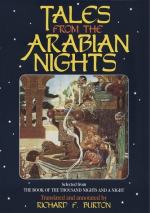[FN#131] In beast stories generally when man appears he shows to disadvantage.
[FN#132] Shakespeare’s “stone bow” not Lane’s “cross-bow” (ii. 53).
[FN#133] The goad still used by the rascally Egyptian donkey-boy is a sharp nail at the end of a stick; and claims the special attention of societies for the protection of animals.
[FN#134] “The most ungrateful of all voices surely is the voice of asses” (Koran xxxi. 18); and hence the “braying of hell” (Koran Ixvii.7). The vulgar still believe that the donkey brays when seeing the Devil. “The last animal which entered the Ark with Noah was the Ass to whose tail Iblis was clinging. At the threshold the ass seemed troubled and could enter no further when Noah said to him:—“Fie upon thee! come in.” But as the ass was still troubled and did not advance Noah cried:—“Come in, though the Devil be with thee!”, so the ass entered and with him Iblis. Thereupon Noah asked:—“O enemy of Allah who brought thee into the Ark ?”, and Iblis answered:—“Thou art the man, for thou saidest to the ass, ’come in though the Devil be with thee!” (Kitab al-Unwan fi Makaid al-Niswan quoted by Lane ii. 54).
[FN#135] Arab. “Rihl,” a wooden saddle stuffed with straw and matting. In Europe the ass might complain that his latter end is the sausage. In England they say no man sees a dead donkey: I have seen dozens and, unfortunately, my own.
[FN#136] The English reader will not forget Sterne’s old mare. Even Al-Hariri, the prince of Arab rhetoricians, does not distain to use “pepedit,” the effect being put for the cause—terror. But Mr. Preston (p. 285) and polite men translate by “fled in haste” the Arabic farted for fear.”
[FN#137] This is one of the lucky signs and adds to the value of the beast. There are some fifty of these marks, some of them (like a spiral of hair in the breast which denotes that the rider is a cuckold) so ill-omened that the animal can be bought for almost nothing. Of course great attention is paid to colours, the best being the dark rich bay ("red” of Arabs) with black points, or the flea-bitten grey (termed Azrak=blue or Akhzar=green) which whitens with age. The worst are dun, cream coloured, piebald and black, which last are very rare. Yet according to the Mishkat al-Masabih (Lane 2, 54) Mohammed said, ’The best horses are black (dark brown?) with white blazes (Arab. “Ghurrah”) and upper lips; next, black with blaze and three white legs (bad, because white-hoofs are brittle):next, bay with white blaze and white fore and hind legs.” He also said, “Prosperity is with sorrel horses;” and praised a sorrel with white forehead and legs; but he dispraised the “Shikal,” which has white stockings (Arab. “Muhajjil”) on alternate hoofs (e.g. right hind and left fore). The curious reader will consult Lady Anne Blunt’s “Bedouin Tribes of the Euphrates, with some Account of the Arabs and their Horses” (1879); but he must remember that it treats of the frontier




